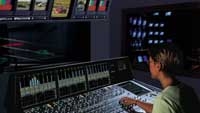Audio consoles

Computer development over the last 50 years supports the notion that an inverse proportionality between size and strength governs our technology. The digital audio workstations and chip-based consoles that have radically reduced the size of the work environment in many areas of the audio industry, including music recording/mixing and audio post, are examples.
The third major area of the audio industry — live, on-air broadcasting — presents challenges that are distinct from the others, primarily in the need for redundancy of features and ease of access to them. A firm understanding of where we are in the evolution of music, post and on-air audio is critical to the success of any company that serves these markets.
One of the most fundamental concepts of music recording has been that tracking and mixing are discrete stages. These days, musicians and producers often record parts, clean them up, comp from various takes and normalize the gain on the completed track as one continuous procedure, obliterating the line between editing and mixing.
Applying reverb to localize multiple tracks can be done at any time. Why leave it to the “mix” stage? If the effect isn't right in the end, an engineer can always retrieve the unprocessed tracks and take a second crack at things.
As a result of the dissolving need to work on many tracks simultaneously, a trend has emerged that favors less physical strips and high-quality components, packaged in consoles that offer an attractive combination of performance and price.
An emphatic ditto may be applied to audio post. One major distinction between the music and post markets is the need for a well-documented, easily accessible database of sound effects that is required in post. Networked servers that can shuttle data to multiple workstations have become essential. The ability to deliver discrete strips of music, dialog and effects on a variety of media, including (amazingly) tape, is still essential. Routing needs make a console more of a required piece of gear in an audio post room than in a music studio.
The specific requirements of on-air broadcasting — which include redundancy, flexible routing and metering — will always distinguish the consoles used in this area of the audio industry from those housed in facilities that specialize in music and audio post work. However, the move toward smaller mixing boards that intelligently spread out at least some of their functionality across multiple layers has clearly reached the on-air market as well.
Get the TV Tech Newsletter
The professional video industry's #1 source for news, trends and product and tech information. Sign up below.
The C100 is a small footprint, assignable console, specifically designed for on-air studio applications, such as news and sports and live-to tape talk and game shows.
Solid State Logic, long associated with large format boards, recenty released the C100 console. It is constructed around a control surface and a DSP rack that can be configured in a variety of ways. Metering is one of the console's assignable features. Using a touchscreen, the operator can assign the meters to reflect the state of any of the console's buses at any time. Although the company continues to place large format consoles in major music rooms and sound stages, it is augmenting its traditional fleet with smaller boards that can serve multiple constituencies, including the on-air market.
Euphonix also recognizes the need for assignability and a smaller work surface. It uses Layouts, templates that let the engineer reconfigure the console at a push a button, bringing critical channels within easy reach. Operation of a large board can be trimmed down so that only the center section is used at certain points.
Sony Electronics addresses both the high- and mid-range console markets with its Oxford and DMX-R100 digital boards. It recently released three products designed to expand the functionality of the DMX-R100. These units — the SIU-100 system expansion interface unit, SIU-RM101 remote control and the DMBK-S101 8-channel mic pre amp board — allow for audio networking of both analog and digital audio signals with multiple consoles, thereby expanding the digital board's I/O capabilities.
The SIU-100 was designed with the broadcast industry in mind. A typical usage would involve a broadcast production facility that has placed the system expansion interface unit on the production stage linked to a pair of DMX-R100 consoles located in two separate audio control rooms. In this scenario, mic-pres could easily be networked between the two consoles.
And at this year's AES and NAB conventions, Calrec launched the Zeta 100 digital console. More compact than the earlier Sigma 100 console, the unit's surface can be configured to hold 24, 32 or 48 faders.
Gary Eskow is a composer and journalist who lives in New Jersey. He's held a number of editorial positions in the field of audio journalism and is currently a contributing editor at Mix magazine.
